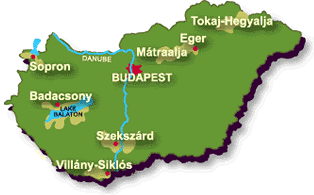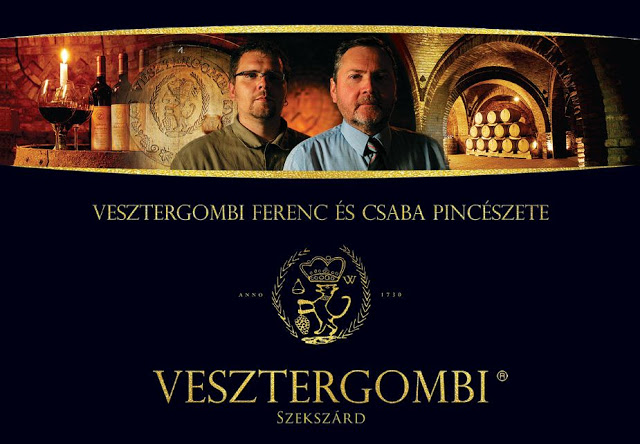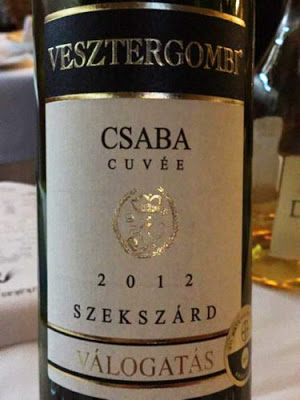
Mapa de Hungría en regiones de vino. Fuente [en línea]: www.schiller-wine.blogspot.com.es
JAVIER HERNÁNDEZ. Voy a ser sincero, cuando empecé en el sector del vino, cada vez que me preguntaban sobre grandes regiones vitivinícolas de Europa Central, no podía evitar hacer referencia a las regiones del vino comodines, como Burdeos, Rioja y Toscana. Perdona mi ignorancia, pero no fue hasta hace poco tiempo que descubrí los impresionantes vinos que se elaboran no tan lejos, hacia el este, del epicentro del mundo viejo del vino. Sí señores, es cierto: Vinos de Europa del Este son buenos! Existen y llevan existiendo desde hace siglos. De hecho, son tan sorprendentemente deliciosos como cualquier otro mosto de uva mediterránea fermentado al que se le puede pegar una pegatina dorada de Mundus Vini.
En esta sección, me centraré en un tinto exquisitamente envejecida de la región vinícola de Szekszárd en Hungría, casa de la «Sangre de Toro de Szekszárd”. El nombre del vino con la que tuve la gran fortuna de tropezarme mientras vagueaba por el enorme pabellón no convencional de Europa del Este durante Prowein del año pasado, es Csaba Cuvée de la bodega Vesztergombi.
¿Comercio justo?
¿Comercio justo?
Lo recuerdo con claridad. Me encontré con este pequeño puesto ubicado modestamente entre las secciones de Rumanía y Bulgaria en la inmensa Messe. Me sorprendió al ser recibido tan cálidamente por el joven húngaro de aspecto cansado, a pesar del hecho de que ya era la tarde del último día de la feria de tres días de duración y muchos de sus compatriotas ya se habían marchado a casa o bien estaban barriendo el entorno como yo, tratando de adquirir las últimas interesantes muestras sobrantes mediante el trueque, al igual como los hacíamos con los cromos.
No acabo de recordar cual botella de vino tinto español había intercambiado para hacerme con esta gema húngara de rubí oscuro, pero estoy seguro de que si la situación fuera inversa, no hubiera sido un vino merecedor por la que prescindiría de la Csaba.
La nota del día
Csaba es el vino insignia de la bodega y consiste de una mezcla de vinos de producciones limitadas a base de Cabernet Sauvignon, Cabernet Franc y Merlot de excelentes cosechas. Después de 20-24 meses de crianza en barrica de roble, es envejecido aún más en botella durante un año.
Nombrado en honor del bis bis nieto y heredero del legado vinícola de la familia, Csaba, o «Csabiból» tal y como su familia le llamaban de niño, es un viticultor logrado y enólogo en su propio derecho.
Recuerdo descorchar esa botella de vino húngaro por primera vez durante la cena inaugural con mi nuevo compañero de piso de recién fichaje y reiterar entre nosotros en varias ocasiones lo bueno que estaba el vino mientras que nos desenvolvíamos en una conversación filosófica intensa y profunda, efecto secundario de la alta graduación, seguramente.
El color granate oscuro con reflejos rubí, un vino con mucho cuerpo, taninos sutiles y ricos, sabores y aromas de las tres variedades que contribuyen a su gran estructura para tan corto envejecimiento en barrica. Lo más sorprendente de todo es el gran equilibrio y acidez que mantenía el Csaba, su persistencia no sólo dio de sí para llenar mi boca con su bondad satinada y plácido goteo por mi garganta, pero también pudo enmascarar los 15,4 grados (¡para darse bofetadas!) que podrían haber pasado desapercibidos si no hubiera aparecido escrito en la etiqueta trasera.
Según viejos documentos procedentes del siglo XVIII, la familia Vesztergombi lleva cultivando la uva y la elaboración del vino desde hace cientos de años. La bodega Vesztergombi crece uvas en 30 hectáreas de terreno repartidos en cinco viñedos en la región Szekszárd. La bodega produce variedades internacionales como el Cabernet Sauvignon, Cabernet Franc y Merlot, sin embargo, se presta especial atención a las variedades autóctonas, como la Kadarka, la Kékfrankos y el famoso ‘Sangre de Toro de Szekszárd’.
Aliado a su padre Ferenc, el antiguamente galardonado «enólogo del año», ambos están a los mandos del negocio y juntos elaboran premiadas obras maestras que representan, orgullosamente, la poco conocida pero exquisita tradición vinícola de la región de Szekszárd.
THIRSTY AND HUNGARY FOR YOU. (ENGLISH VERSION)
I’ll be the first to admit it, when I started out in the wine sector I couldn’t help but reference the pretext wine regions, such as Bordeaux, Rioja and Tuscany when asked about great Central European wine regions. Forgive my ignorance, but not too long ago did I know of great soups being made not too far east from the heart of the wine producing old world.
Yes folks, that right: Eastern European Wines! They do exist and have been around for centuries. IN fact, they are just as surprisingly delicious as any other Mediterranean fermented grape juice you can slap a Mudus Vini gold sticker on.
In this section, I will be focusing on an exquisitely aged red from the Szekszárd wine region of Hungary, home of the ‘Bull’s Blood of Szekszárd’. The name on the wine I had the great fortune of stumbling upon whilst roaming around the unconventional Eastern Europe pavilion at last year’s Prowein, is Csaba Cuvée from the Vesztergombi winery.
A fair trade?
I remember it clearly. I came across this small stand nestled unassumingly between the Romanian and Bulgarian sections of the immense messe. I was surprised to be greeted so warmly by a young and weary-looking Hungarian chap, despite the fact that it was well into the late hours of the last day of the three-day-long affair and many of his compatriots had either already packed up and gone home or were also scavenging around as I was, trying to come up on some interesting left-over samples by means of bartering bottles like baseball cards.
I don’t quite remember which bottle of Spanish red I had traded for this dark ruby Hungarian gem, but I’m sure it wasn’t anything I would have ever wanted in exchange had the roles been reversed.
The lowdown
Csaba is the winery’s flagship wine and is a blend of limited harvest wines made from the Cabernet Sauvignon, Cabernet Franc and Merlot grapes from excellent vintages. After 20-24 months of oak barrel aging, it is further aged in bottle for another year.
Named after the great-great-grand son and heir to the family wine-making legacy, Csaba “Csabiból” as his family would refer to him as a child, is an achieved vintner and wine maker in his own right.
I recall popping open this bottle for the first time with my newly installed flatmate on the evening of his arrival and reiterating on various occasions how good it was while an intense philosophical conversation ensued over that unforgettable inaugural dinner.
The deep red, heavy bodied wine is blackish in color, with subtle tannins and rich flavors and aromas from the three varieties which contribute to wine´s great structure for such short barrel aging. Most shocking of all is the great balance and acidity that gave Csaba the persistence to not only fill my mouth with its satiny goodness and trickle soothingly down my throat, but also mask the head-slapping 15.4% ABV that could have gone unnoticed had it not been written on the back label!!
According to written documents found in the 18th century, the Vesztergombi family has been growing grapes and making wine for hundreds of years. The Vesztergombi winery grows grapes on 30 hectares of land spread out over five vineyards in the Szekszárd region. The winery produces international varieties such as Cabernet Sauvignon, Cabernet Franc and Merlot, however it pays special attention to local varieties, like Kadarka, Kékfrankos and the famous ‘Bull’s Blood of Szekszárd’.
Partnered by his father Ferenc, former “Wine maker of the year”, the pair run the show and together make award-winning masterpieces that proudly represent the little-known yet exquisite wine-making tradition of the Szekszárd region.
About Javier Hernández
- Web |
- More Posts(5)



